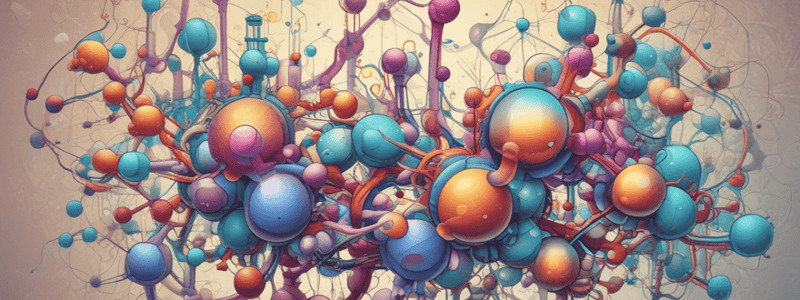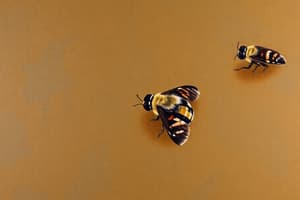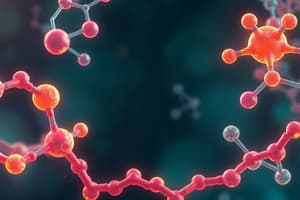Podcast
Questions and Answers
What is the preferred stereochemistry of amino acids in natural proteins?
What is the preferred stereochemistry of amino acids in natural proteins?
- R-configuration
- L-configuration (correct)
- S-configuration
- D-configuration
What is a consequence of the asymmetry of the surface of proteins?
What is a consequence of the asymmetry of the surface of proteins?
- Protein synthesis
- Protein denaturation
- Formation of asymmetric protein structures
- Highly specific molecular recognition of binding targets (correct)
What role does the stereochemistry of amino acids play in protein structure?
What role does the stereochemistry of amino acids play in protein structure?
- Protein synthesis
- Denaturation of proteins
- Protein degradation
- Formation of secondary structure (correct)
How are the 20 common amino acids classified?
How are the 20 common amino acids classified?
Where are hydrophobic amino acids usually found in a protein molecule?
Where are hydrophobic amino acids usually found in a protein molecule?
Which amino acid has a side chain that forms a covalent bond with the α-amino group?
Which amino acid has a side chain that forms a covalent bond with the α-amino group?
What is the term used to describe the specific arrangement of amino acids in a protein?
What is the term used to describe the specific arrangement of amino acids in a protein?
Why is the preference for L-amino acids in proteins significant?
Why is the preference for L-amino acids in proteins significant?
What is the direction of the hydrogen bonds in the alpha-helix with respect to the helix axis?
What is the direction of the hydrogen bonds in the alpha-helix with respect to the helix axis?
Which of the following types of secondary structures has a macrodipole moment?
Which of the following types of secondary structures has a macrodipole moment?
What is the characteristic of the side chains in an alpha-helix?
What is the characteristic of the side chains in an alpha-helix?
In a beta-sheet, where are the hydrogen bonds located?
In a beta-sheet, where are the hydrogen bonds located?
What is the characteristic of the side chains in a beta-sheet?
What is the characteristic of the side chains in a beta-sheet?
What is the direction of the side chains in an alpha-helix?
What is the direction of the side chains in an alpha-helix?
What is the characteristic of the side chains in a beta-sheet?
What is the characteristic of the side chains in a beta-sheet?
What is the handedness of the n = -3 helix?
What is the handedness of the n = -3 helix?
What is the primary structure of a protein?
What is the primary structure of a protein?
What is the outcome of strong mineral acid, such as 6 M HCl, on peptide bonds?
What is the outcome of strong mineral acid, such as 6 M HCl, on peptide bonds?
What is the role of proteolytic enzymes in peptide bond hydrolysis?
What is the role of proteolytic enzymes in peptide bond hydrolysis?
What is the relationship between DNA sequence and protein sequence?
What is the relationship between DNA sequence and protein sequence?
What is the central dogma in the context of gene expression?
What is the central dogma in the context of gene expression?
What is a characteristic of proteins, such as insulin, after translation?
What is a characteristic of proteins, such as insulin, after translation?
What is the reason for the slow rate of peptide bond hydrolysis in aqueous solutions at physiological pH and temperature?
What is the reason for the slow rate of peptide bond hydrolysis in aqueous solutions at physiological pH and temperature?
What is the outcome of using chemicals that cleave at specific sites, such as CNBr, on peptide bonds?
What is the outcome of using chemicals that cleave at specific sites, such as CNBr, on peptide bonds?
What is the main function of collagen in the body?
What is the main function of collagen in the body?
What is the characteristic of every third residue in collagen?
What is the characteristic of every third residue in collagen?
What is the result of a deficiency in Vitamin C?
What is the result of a deficiency in Vitamin C?
What is the repetitive motif in the sequence of collagen?
What is the repetitive motif in the sequence of collagen?
What is the effect of cross-linking on collagen?
What is the effect of cross-linking on collagen?
What is the role of hydroxyproline and hydroxylysine in collagen?
What is the role of hydroxyproline and hydroxylysine in collagen?
What is the structure of the tropocollagen molecule?
What is the structure of the tropocollagen molecule?
What is the result of the oxidation of lysine side chains?
What is the result of the oxidation of lysine side chains?
What is the necessary condition for protein folding to occur?
What is the necessary condition for protein folding to occur?
Which of the following factors contributes to the stability of the folded structure of a globular protein?
Which of the following factors contributes to the stability of the folded structure of a globular protein?
What is the primary role of disulfide bonds in protein structure?
What is the primary role of disulfide bonds in protein structure?
What is the typical timescale for the folding of globular proteins from their denatured conformations?
What is the typical timescale for the folding of globular proteins from their denatured conformations?
What is NOT a characteristic of protein folding?
What is NOT a characteristic of protein folding?
What is the environment inside most cells with respect to sulfhydryl groups?
What is the environment inside most cells with respect to sulfhydryl groups?
What is the role of internal disulfide bonds in protein structure?
What is the role of internal disulfide bonds in protein structure?
What is the significance of the rapid kinetics of protein folding?
What is the significance of the rapid kinetics of protein folding?
Flashcards are hidden until you start studying
Study Notes
Stereochemistry of the α-Amino Acids
- α-Amino acids' stereochemistry is designated as D- or L-, which is best visualized from its Fischer projection.
- There is a preference for L-amino acids in proteins.
- The preference for L-amino acids in natural proteins has two important consequences:
- The surface of any given protein is asymmetric, which is the basis for the highly specific molecular recognition of binding targets by proteins.
- The stereochemistry of the amino acids plays an important role in the formation of so-called "secondary structure" and thereby the overall structure of proteins.
Properties of the Amino Acid Side Chains
- The 20 common amino acids are classified by their side chains:
- Aliphatic
- Hydroxyl or sulfur-containing
- Aromatic
- Basic
- Acidic and their amides
- The more hydrophobic amino acids, such as isoleucine, are usually found within the core of a protein molecule, where they are shielded from water.
- Proline is the only amino acid in which the side chain forms a covalent bond with the α–amino group.
Peptides and the Peptide Bond
- While hydrolysis of peptide bonds is thermodynamically favored in aqueous solutions, the reaction is exceedingly slow at physiological pH and temperature.
- Peptide bond hydrolysis can be achieved by:
- Strong mineral acid (e.g., 6 M HCl) cleaves all peptide bonds (including the Asn and Gln amide bonds).
- Chemicals that cleave at specific sites (e.g., CNBr cleaves at Met).
- Proteolytic enzymes (proteases) that cleave at specific sites.
Proteins: Polypeptides of Defined Sequence
- Every protein has a defined number and order of amino acid residues, referred to as the primary structure of the protein.
- The primary structure of a protein corresponds to the DNA (gene) sequence.
- The genetic code is responsible for the translation of DNA into protein.
Post-translational Modification
- Many proteins, such as insulin, undergo post-translational modification.
Secondary Structure: Regular Ways to Fold the Polypeptide Chain
- There are two main types of secondary structures:
- The α-helix, where the hydrogen bonds are within a single polypeptide chain and are almost parallel to the helix axis.
- The β-sheet, where the hydrogen bonds are between adjacent chains and are nearly perpendicular to the chains.
- The 3₁₀ helix is less common than the α-helix.
- Secondary structures can be amphiphilic (or amphipathic), displaying a predominantly hydrophobic face opposite a predominantly hydrophilic face.
- The α-helix has side chains of similar polarity every 3–4 residues.
- The β-strand has alternating polar and nonpolar side chains.
Fibrous Proteins: Structural Materials of Cells
- Collagen is a fibrous protein that forms the matrix material in bone, constitutes the major portion of tendons, and is an important constituent of skin.
- The basic unit of the collagen fiber is the tropocollagen molecule, a triple helix of three polypeptide chains.
- The chains wrap around each other in a right-handed sense, with hydrogen bonds between the chains.
- Every third residue can be only glycine.
- Hydroxyproline and hydroxylysine are present in collagen.
- A repetitive motif in the sequence is of the form Gly–X–Y, where X is often proline and Y is proline or hydroxyproline.
Scurvy and Collagen Weakening
- Scurvy is a connective tissue disease caused by a deficiency in Vitamin C (ascorbic acid), leading to weakened collagen fibers.
- The disease is caused by failure to hydroxylate prolines and lysines in collagen, resulting in less hydrogen bonding between the chains of tropocollagen.
Cross-Linking in Collagen
- Lysine side chains can oxidize to aldehyde derivatives, which can react with either a lysine residue or with one another to produce a cross-link.
- This process continues through life, making the collagen steadily less elastic and more brittle.
Factors Determining Secondary and Tertiary Structure
- The stability of the folded structure of a globular protein depends on the interplay of three factors:
- The unfavorable conformational entropy change, which favors the unfolded state.
- The favorable enthalpy contribution arising from intramolecular interactions.
- The favorable entropy change arising from the burying of hydrophobic groups within the molecule.
- The role of disulfide bonds in stabilizing the folded structure.
Dynamics of Globular Protein Structure
- The folding of globular proteins from their denatured conformations is a remarkably rapid process, often complete in less than a second.
- Protein folding is not a completely random search through a vast conformational space, but rather takes place through a series of intermediate states.
Studying That Suits You
Use AI to generate personalized quizzes and flashcards to suit your learning preferences.





